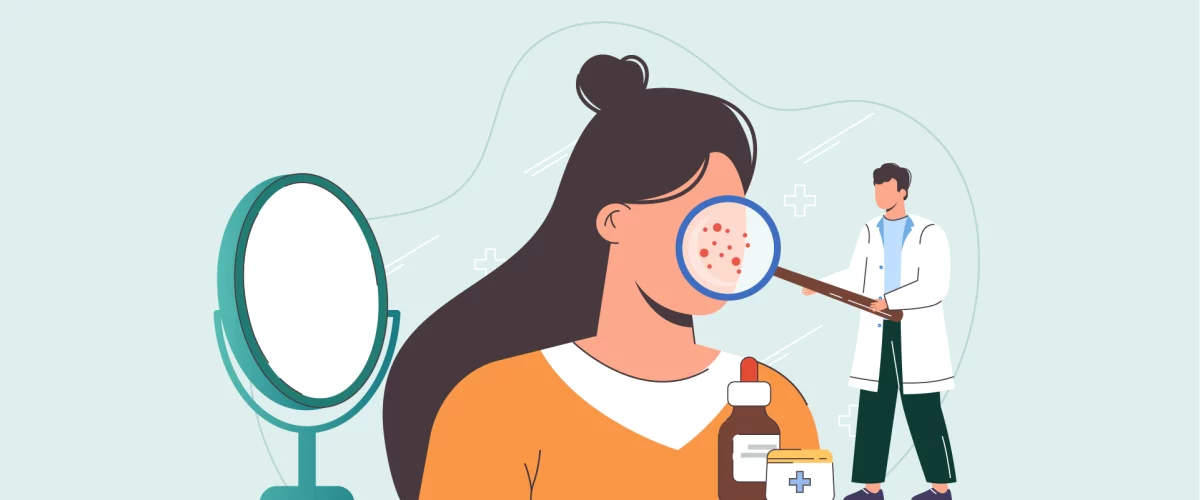Ocular Rosacea is a chronic condition that can cause redness, discomfort, and dryness in the eyes. This disease, often linked with skin rosacea, can affect the eyelids and the cornea, leading to symptoms like light sensitivity and a gritty feeling in the eyes. Various treatments, ranging from artificial tears to IPL, are available to manage these symptoms and enhance eye health. Let’s delve into understanding ocular rosacea and its connection to dry eye symptoms.
What is Ocular Rosacea?
Ocular Rosacea is an inflammatory condition that predominantly affects the ocular surface and eyelids. It is a subtype of the skin condition, rosacea, and is characterized by a similar set of symptoms. Though the exact cause remains unknown, it is noted that environmental factors such as excessive sun exposure may contribute to its onset. It can result in a variety of symptoms including but not limited to redness, burning, and irritation in the eyes, and in severe cases, can lead to blurred vision. To treat rosacea, various treatments are available to manage the symptoms.
Common Symptoms of Ocular Rosacea
Redness around the Eyes
Redness around the eyes is one of the most prevalent symptoms of ocular rosacea. It is usually a result of the dilation of small blood vessels on the white part of the eye. This can cause the eyes to look bloodshot or pink, and may even lead to discoloration around the eyes. In some cases, the redness can be accompanied by a burning sensation, increasing the discomfort. This redness can be intermittent, appearing and disappearing in response to certain triggers such as sun exposure, spicy foods, or alcohol consumption. However, in severe cases, the redness may become chronic and persistent. It’s crucial to note that this symptom could also be indicative of other eye conditions, so a thorough examination by a healthcare professional is recommended.
Dryness and Itching
Dryness and itching are common symptoms of ocular rosacea. Dryness often results from the dysfunction of meibomian glands, responsible for producing oils to keep the eye surface lubricated. The malfunctioning of these glands can disrupt the tear film’s stability, leading to dry eyes.
Itching can be exacerbated by external factors, like dust or allergens. Patients are advised not to rub their eyes, as it can further inflame the area and worsen symptoms.
Swollen Eyelids
Swollen eyelids is another symptom of ocular rosacea. The inflammation can cause the eyelids to appear red and puffy, often accompanied by a sensation of heaviness. Some patients may also experience crusty debris along the eyelid margin, which can be particularly noticeable upon waking. This symptom can lead to further discomfort, as it may feel as if a foreign body is present in the eye. It’s also common for patients to report recurring styes due to this eyelid inflammation. To alleviate swelling, warm compresses can be applied to the eyes, and can help reduce inflammation. However, it’s essential to remember that persistent swelling should be evaluated by a healthcare professional to rule out other potential eye conditions.
Blepharitis: A Related Condition
Blepharitis is a common condition closely related to ocular rosacea, characterized by inflammation of the eyelids. Regularly associated with conditions like rosacea, dry eye, and dandruff, blepharitis can result in symptoms such as redness, swelling, and flaky skin around the eyelids. Similar to ocular rosacea, blepharitis is chronic and often alternates between periods of remission and exacerbation.
Common symptoms of blepharitis include a gritty or burning sensation in the eyes, red and swollen eyelids, and a crusty discharge along the eyelashes.
This condition is not curable, but its symptoms can be effectively managed with regular eye care and appropriate treatments.
Links and effects of rosacea
Correlation with Acne and Skin Conditions
Ocular Rosacea often coexists with other skin conditions, including acne and facial rosacea. Although the correlation between these diseases is not entirely understood, it is notable that they often occur concurrently. Acne, characterized by the appearance of pimples and blackheads, might not directly cause ocular rosacea but the two are often found together.
Facial rosacea, a condition causing redness and visible blood vessels in the face, has been found to have a strong association with ocular rosacea. In fact, ocular rosacea can sometimes be the first sign of this skin condition. Understanding the links between these conditions can be beneficial in early detection and treatment.
How Ocular Rosacea Can Affect the Cornea?
Ocular rosacea can significantly affect the cornea, the clear front surface of the eye. The disorder can lead to dry eyes due to tear evaporation, which in turn can cause complications on the corneal surface. These complications may manifest as visual symptoms.
Furthermore, inflammation that starts in the eyelids can cause secondary irritation to the cornea. This can happen due to misdirected eyelashes or other complications. Moreover, ocular rosacea can result in increased tear concentrations of certain inflammatory substances, leading to a decrease in tear volume and worsening of dry eye symptoms. These effects on the cornea underline the complexity of ocular rosacea and its potential to disrupt eye health.
Can rosacea cause dry eyes?
Yes, rosacea can indeed cause dry eyes. This connection primarily stems from the inflammatory nature of rosacea, which often affects the oil-producing glands in the eyelids, known as the meibomian glands. When these glands become inflamed, they produce less oil or poorer quality oil, which is crucial for maintaining a stable tear film on the surface of the eye. Without adequate oil, tears evaporate too quickly, leading to dry eye symptoms such as irritation, burning, and a gritty feeling. Additionally, inflammation associated with rosacea can directly impact the ocular surface, exacerbating dryness and discomfort. Therefore, managing rosacea effectively is essential in alleviating dry eye symptoms and maintaining overall eye health.
How do you treat rosacea in the eyes?
The Role of Artificial Tears
Artificial tears, also known as lubricating eye drops, play a significant role in relieving the symptoms of ocular rosacea. They primarily target dryness, one of the most common complaints associated with this condition. Artificial tears function by supplementing the natural tear film, helping to stabilize its oily layer. This action not only aids in maintaining eye moisture but also minimizes the fluctuation in tear film, thus reducing the severity of dry eye syndrome. Over-the-counter artificial tears and tear film supplements are commonly used options. However, in most cases, it can’t be enough, because it’s not sustainable. So there are other treatments that are more long-lasting, such as IPL.
The benefits of IPL in treatment of rosacea
Intense Pulsed Light (IPL) therapy has emerged as a promising treatment for managing rosacea, particularly in ophthalmology. IPL involves the use of broad-spectrum light to target and reduce inflammation and abnormal blood vessels associated with rosacea. In the context of ocular rosacea, IPL has shown benefits in improving the function of meibomian glands. By reducing the inflammatory mediators and opening up clogged glands, IPL helps restore the normal oil layer of the tear film, which is essential for preventing tear evaporation and maintaining eye moisture. This can lead to a significant reduction in dry eye symptoms and improve overall comfort.
Furthermore, IPL therapy can enhance the cosmetic appearance by reducing redness and swelling around the eyes, contributing to better skin and ocular health. Regular sessions of IPL, as recommended by an eye care professional, can provide lasting relief from the chronic symptoms of ocular rosacea and Meibomian Gland Dysfunction.
Lifestyle Adjustments to Manage Ocular Rosacea
Maintaining Clean Eyelids to Reduce Symptoms
Keeping eyelids clean is a crucial step to manage ocular rosacea and dry eye symptoms. Daily eyelid hygiene can prevent the buildup of skin scales along the eyelashes, which can cause irritation and exacerbate symptoms. A simple daily routine can make a significant difference.
- Start by applying a USB heating mask to your eyelids for 8 to 15 minutes. This heat helps liquefy the oil in the Meibomian glands, allowing it to flow more easily.
- Then, blink strongly under your mask, after 6 min. Blink between 3 and 5 times (both eyelids should be touching).
- Finally, clean your eyelids with wipes for sensitive eyes, non-irritating cleanser.
Remember, consistency in eyelid hygiene can help reduce the frequency of rosacea flare-ups and keep symptoms under control.
The Impact of Diet on Ocular Rosacea
The link between diet and ocular rosacea is an area of significant interest and ongoing research. Certain foods and beverages can trigger or exacerbate symptoms, with spicy foods and alcohol commonly identified as culprits. Interestingly, tomatoes and tomato-based products are also known to potentially trigger rosacea flare-ups due to their high acidity and histamine content, which can provoke inflammatory responses in some individuals.
On the flip side, a diet rich in Omega-3 fatty acids, found in fish and flaxseeds, may help reduce inflammation and improve ocular rosacea symptoms, including dry eyes. Incorporating probiotics, which promote a healthy gut, may also offer benefits. Since dietary impacts can vary from person to person, maintaining a food diary can help identify specific triggers or beneficial foods. By understanding and adjusting dietary habits, individuals with ocular rosacea can better manage their symptoms and maintain eye health.




